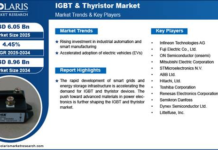
The load break switch (LBS) and air load break switch market is a key component of modern electrical distribution systems. Designed to interrupt or isolate electrical loads under normal operating conditions, these devices provide protection against faults and enable maintenance without disrupting supply. With the growing demand for electricity and the expansion of renewable energy systems, LBS and air load break switches have become essential for efficient power management. Let’s explore the fundamentals of these devices and the key factors that are driving their increased adoption.
LBS and Air Load Break Switches: Introduction
Load break switches are widely deployed in medium-voltage networks to ensure operational flexibility and safety. Air break switches are a subcategory of LBS. Air LBS are known for their ability to interrupt current in air-insulated systems safely. These switches are used in various applications, including utility grids, industrial plants, and commercial buildings. They facilitate load switching, isolation, and fault protection. These devices are also being integrated into modern electrical networks with smart monitoring systems to improve fault detection, reduce downtime, and support preventive maintenance.
Working of LBS and Air Load Break Switches
Load Break Switches (LBS) are designed to safely interrupt electrical current under load conditions. The basic working principle involves opening and closing a circuit while it is energized. The opening and closing of the circuit is facilitated by a mechanical switching mechanism that can handle normal load currents as well as transient currents during switching operations. When the switch is closed, current flows freely through the conductive path. To open the circuit, the switch separates its contacts in a controlled manner.
Air load break switches operate on a similar principle but rely specifically on air as the medium to extinguish the arc generated during the switching process. When the contacts separate, the electrical arc forms between them. The design of the switch directs the arc into a controlled path. This rapidly cools and extinguishing it before it can cause damage. The mechanism in air load break switches ensures that current interruption is safe and reliable even under load conditions.
Key Market Highlights
- The LBS and air load break switch market is projected to witness sustained growth, according to the latest analysis by Polaris Market Research.
- The market was valued at USD 3.1 billion in 2024 and is projected to reach USD 4.9 billion by 2034.
- The market is expected to register a CAGR of 4.8% from 2025 to 2034.
Major Market Drivers
Below, we’ve explained to you the various factors fueling the demand for LBS and air load break switches:
Infrastructure Expansion
One of the key factors fueling market demand is the continuous expansion of electrical infrastructure. Rising electricity demand, driven by urbanization and population growth, is prompting utilities and industries to invest heavily in medium-voltage distribution networks. Load break switches are integral to these networks as they ensure reliable load interruption and isolation capabilities that enable safe operation and maintenance. With new residential, commercial, and industrial projects being undertaken, the need for robust and flexible switching devices continues to grow.
Rising Integration of Renewable Energy
The increasing adoption of renewable energy sources, including solar, wind, and microgrid systems, is another key growth factor. Integrating decentralized power generation into existing electrical grids requires switching devices capable of handling variable loads and intermittent energy flows. LBS and air load break switches facilitate safe connection and disconnection of renewable energy sources. Their ability to manage fluctuating currents and provide precise load control makes them essential components in the transition toward sustainable and diversified energy systems.
Emerging Trends Shaping Market Landscape
Here’s a look at the key trends shaping the LBS and air load break switch market landscape:
Introduction of Smart Switches
One of the most significant trends shaping the market landscape is the rising integration of smart technologies into LBS and air load break switches. The incorporation of IoT sensors, communication modules, and data analytics allows these switches to provide real-time monitoring, fault detection, and remote operation. Power grids and utilities can now track load conditions, identify potential faults, and respond quickly to disruptions without sending personnel on-site.
Compact and Modular Designs
Manufacturers are increasingly focusing on compact and modular switch designs that are lightweight and easy to install. These designs allow for faster deployment in both new and existing electrical networks, reducing installation time and costs. Modular switches can be easily expanded or upgraded as network requirements change. This provides utilities with flexible solutions to accommodate urban grid expansion, industrial facilities, or renewable energy integration.
Conclusion
The load break switch (LBS) and air load break switch market is poised for steady growth as the demand for safe, reliable, and flexible power distribution continues to rise. With increasing adoption of renewable energy and technological innovations in smart switching, these devices are central to building resilient and efficient distribution networks.

















